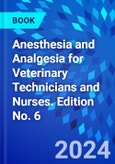Master the veterinary technician's role as a veterinary anesthetist! Covering the principles of animal anesthesia and pain management, Anesthesia and Analgesia for Veterinary Technicians and Nurses, 6th Edition is the definitive guide to the latest drugs, techniques and protocols, and anesthetic equipment. Clear guidelines to anesthesia administration include pre-anesthetic preparation of the patient, induction procedures, the monitoring of patients' vital signs during the anesthetic period, and postoperative care. Written by expert educators John A. Thomas and Philip Lerche, this trusted text prepares you for success in the classroom and on the Veterinary Technician National Exam (VTNE).
- Comprehensive coverage of dogs, cats, horses, cattle, camelids, and swine makes this an excellent resource for veterinary students and technicians.
- Illustrated, step-by-step guidelines to common procedures include patient preparation, IV catheter placement, anesthetic induction techniques, endotracheal intubation, anesthetic maintenance techniques, and anesthetic recovery.
- Two large-animal anesthesia chapters cover pain management and anesthetic techniques for equine, ruminant, camelid, and swine patients.
- Reference tables and boxes provide quick access to fluid administration rates, properties of anesthetic drugs, oxygen flow rates, anesthetic protocols, normal and abnormal monitoring parameters, and more.
- Learning features include chapter outlines, learning objectives, key terms, Technician Notes, key points, review questions, and suggested readings.
- Glossary at the end of the text makes it easy to look up definitions of terms.
- NEW! Content on anesthetic practices used to improve patient outcomes includes anesthetic safety checklists, anxiolysis, minimization of anatomical dead space, and administration of constant rate infusions.
- NEW! Updates reflect the latest advances in veterinary anesthesia and analgesia including new fasting recommendations, drugs, equipment, and anesthetic protocols.
- NEW! Expanded coverage includes equipment care and sanitation, management of hypothermia, and local anesthetic techniques used to provide analgesia.
- NEW! Updated practice guidelines provide the basis for anesthesia information, including the 2022 AAHA Pain Management Guidelines for Dogs and Cats and the 2020 AAHA Anesthesia and Monitoring Guidelines for Dogs and Cats.
- NEW! Revised and additional reference tables and charts enhance their ease of use for routine tasks such as calculation of IV fluid administration rates and oxygen flow rates, and interpretation of monitoring data.
Table of Contents
1. Introduction to Anesthesia
2. Patient Preparation
3. Anesthetic Agents and Adjuncts
4. Anesthetic Equipment
5. Workplace Safety
6. Anesthetic Monitoring
7. Special Techniques
8. Analgesia
9. Canine and Feline Anesthesia
10. Equine Anesthesia
11. Anesthesia of Ruminants, Camelids, and Swine
12. Rodent and Rabbit Anesthesia
13.?Anesthetic Problems and Emergencies
Appendices
- Appendix A: Barbiturates
- Appendix B: Halothane
- Appendix C: Nitrous Oxide
- Appendix D: Use of Nonprecision Vaporizers
- Appendix E: Procedure for Operation of a Closed Rebreathing System
- Appendix F: American College of Veterinary Anesthesia and Analgesia Monitoring Guidelines Update, 2009
- Appendix G: Equipment and Drugs for Use in an Emergency Crash Kit
- Appendix H: Standard Volumes, Weights, Measures, and Equivalents
Answer Key
Glossary
Index








